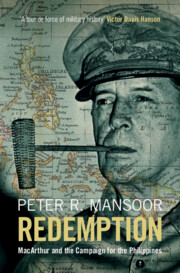Refine search
Actions for selected content:
15366 results in Military history
Index
-
- Book:
- The Colonial Way of War
- Published online:
- 04 September 2025
- Print publication:
- 21 August 2025, pp 352-360
-
- Chapter
- Export citation
2 - Colonial Warfare: Case Studies
-
- Book:
- The Colonial Way of War
- Published online:
- 04 September 2025
- Print publication:
- 21 August 2025, pp 76-128
-
- Chapter
- Export citation
Maps
-
- Book:
- The Colonial Way of War
- Published online:
- 04 September 2025
- Print publication:
- 21 August 2025, pp vii-vii
-
- Chapter
- Export citation
Abbreviations
-
- Book:
- The Colonial Way of War
- Published online:
- 04 September 2025
- Print publication:
- 21 August 2025, pp xii-xii
-
- Chapter
- Export citation
Contents
-
- Book:
- The Colonial Way of War
- Published online:
- 04 September 2025
- Print publication:
- 21 August 2025, pp v-vi
-
- Chapter
- Export citation
1 - Colonial Warfare
-
- Book:
- The Colonial Way of War
- Published online:
- 04 September 2025
- Print publication:
- 21 August 2025, pp 38-75
-
- Chapter
- Export citation
3 - Transimperial Knowledge
-
- Book:
- The Colonial Way of War
- Published online:
- 04 September 2025
- Print publication:
- 21 August 2025, pp 129-187
-
- Chapter
- Export citation
A Note on Language
-
- Book:
- The Colonial Way of War
- Published online:
- 04 September 2025
- Print publication:
- 21 August 2025, pp xi-xi
-
- Chapter
- Export citation
References
-
- Book:
- The Colonial Way of War
- Published online:
- 04 September 2025
- Print publication:
- 21 August 2025, pp 315-351
-
- Chapter
- Export citation
Copyright page
-
- Book:
- The Colonial Way of War
- Published online:
- 04 September 2025
- Print publication:
- 21 August 2025, pp iv-iv
-
- Chapter
- Export citation

Redemption
- MacArthur and the Campaign for the Philippines
-
- Published online:
- 14 August 2025
- Print publication:
- 14 August 2025
10 - The Central and Southern Philippines
-
- Book:
- Redemption
- Published online:
- 14 August 2025
- Print publication:
- 14 August 2025, pp 391-417
-
- Chapter
- Export citation
2 - Soldiers
-
- Book:
- Making Antifascist War
- Published online:
- 28 October 2025
- Print publication:
- 14 August 2025, pp 64-91
-
- Chapter
- Export citation
12 - Wars of dynasties, wars of empires: The nature of European conflicts, 1648–1792
-
-
- Book:
- The Cambridge History of War
- Published online:
- 18 July 2025
- Print publication:
- 14 August 2025, pp 309-341
-
- Chapter
- Export citation
6 - The Battle for Leyte
-
- Book:
- Redemption
- Published online:
- 14 August 2025
- Print publication:
- 14 August 2025, pp 221-269
-
- Chapter
- Export citation
Conclusion
- from Part III - The Downfall
-
- Book:
- The Generalissimo
- Published online:
- 31 July 2025
- Print publication:
- 14 August 2025, pp 229-234
-
- Chapter
- Export citation
Copyright page
-
- Book:
- Making Antifascist War
- Published online:
- 28 October 2025
- Print publication:
- 14 August 2025, pp iv-iv
-
- Chapter
- Export citation
2 - ‘That most imperfect military organization’
- from Part I - The Ascent
-
- Book:
- The Generalissimo
- Published online:
- 31 July 2025
- Print publication:
- 14 August 2025, pp 43-65
-
- Chapter
- Export citation
5 - Leyte Gulf
-
- Book:
- Redemption
- Published online:
- 14 August 2025
- Print publication:
- 14 August 2025, pp 174-220
-
- Chapter
- Export citation
5 - The Real Thing
- from Part II - The Enigma of Consensus
-
- Book:
- The Generalissimo
- Published online:
- 31 July 2025
- Print publication:
- 14 August 2025, pp 111-137
-
- Chapter
- Export citation
